| Article ID | Journal | Published Year | Pages | File Type |
|---|---|---|---|---|
| 3940850 | Fertility and Sterility | 2015 | 4 Pages |
ObjectiveTo reevaluate the rate of correct diagnosis of ovarian torsion (OT) in our department.DesignRetrospective computerized chart review.SettingTertiary referral center.Patient(s)Seventy-eight women who underwent laparoscopy for suspected OT.Intervention(s)Laparoscopy.Main Outcome Measure(s)Rate of true diagnosis of torsion, correlation with Doppler studies.Result(s)The preoperative diagnosis of OT was confirmed in only 36 (46.1%) of the patients. Immediate operation (<10 hours) after admission (n = 48) was associated with a statistically significantly higher likelihood of operatively confirming OT (56.2% vs. 28.6%). We found that the lack of ovarian blood flow on Doppler sonography was a good predictor of OT; women with pathologic flow were statistically significantly more likely to have OT (77% vs. 29%). The sensitivity and specificity of abnormal ovarian flow for OT were 43.8% and 91.7%, respectively, with a positive and negative predictive value of 78% and 71%, respectively.Conclusion(s)Despite 20 years of research, the accuracy of the preoperative diagnosis of OT remains low. The urge to operate can be attributed to the importance of preserving ovarian function in young women as well as to the availability and the low associated complication rate of laparoscopy.
